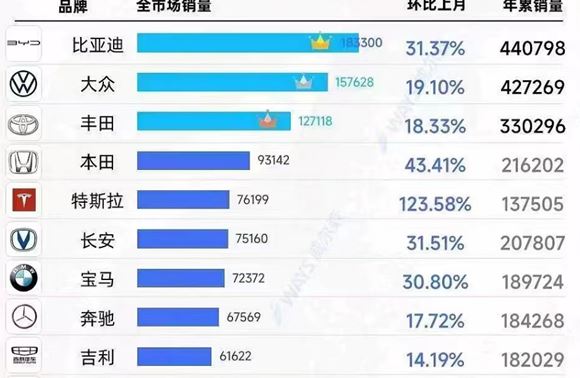In the second quarter, Tesla achieved impressive production and delivery numbers, manufacturing 479,700 cars and delivering 466,140. Although these figures are record-breaking for Tesla, they do not surpass the numbers achieved by BYD in the plugin vehicle industry. BYD, a Chinese company, sold a remarkable 703,561 new energy vehicles in the same quarter, with 700,244 of them being passenger cars.
However, it is important to note that this is not an exact comparison between Tesla and BYD. Unlike Tesla, BYD produces not only passenger vehicles but also commercial vehicles like trucks, buses, and construction equipment. Additionally, BYD manufactures a significant number of plug-in hybrid passenger cars. The Chinese government defines new energy vehicles as those that do not solely rely on internal combustion engines. Therefore, the overall statistics reflect both battery electric vehicles (BEVs) and plug-in hybrids. In the pure BEV category, Tesla still holds the lead.
BYD’s sales performance in the first half of 2022 is impressive, with a total of 1,255,637 new energy vehicles sold, marking a nearly 96% increase compared to the previous year. It is worth mentioning that BYD ceased the production of internal combustion engine cars in March of the previous year.
While some may expect BYD’s sales numbers to overshadow Tesla’s, it is important to recognize that the Chinese new car market is thriving, and there are several companies competing for the crown in the electric vehicle industry. Tesla currently focuses on premium automobiles, starting at the top of the market and working its way down. In contrast, BYD targets the mass market, aiming to sell 3 million electric cars (BEV and PHEV) this year. Each company has its own approach and target audience, with Tesla emphasizing high-tech features and BYD prioritizing affordability and accessibility.
BYD’s scope extends beyond manufacturing vehicles. It also produces electronics, photovoltaics, and batteries, being the second-largest battery manufacturer in China. The company’s battery technology, such as the LFP (lithium iron phosphate) Blade battery, has gained recognition for its safety features, withstanding extreme conditions without the risk of fires or explosions.
BYD’s expansion plans are noteworthy, as the company aims to establish manufacturing facilities in Europe. It has expressed interest in countries like France, Germany, Spain, and other regions, aiming to start producing EVs in Europe by 2025. By expanding its presence globally and offering a range of models, particularly in the lower end of the market, BYD demonstrates its commitment to electric mobility and its potential to compete with Tesla.
While Tesla’s accomplishments in the second quarter are commendable, it is important to recognize that the electric vehicle revolution involves multiple players. Established automakers such as GM, Ford, Stellantis, Mercedes, BMW, Toyota, Honda, and the Volkswagen Group are also making significant strides in transitioning to electric cars. However, many of these companies still face the challenge of balancing conventional car production while investing in electric vehicles.
BYD’s advantage lies in its singular focus on electric vehicles, having left behind internal combustion engines entirely. This dedicated approach may position BYD well to keep up with Tesla’s advancements. The competition among various companies in the electric vehicle market underscores the growing importance of electric transportation in reducing carbon emissions. Ultimately, a diverse range of automakers catering to different market segments will contribute to a successful transition to electric mobility.

